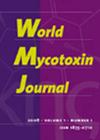Smartphone-based technology for nanomolecular detection of aflatoxin B1 by aptamer-conjugated magnetic nanoparticles
IF 1.7
4区 医学
Q3 FOOD SCIENCE & TECHNOLOGY
引用次数: 0
Abstract
The need for a healthy market in the rapid and accurate screening of a variety of pathogenic agents and toxins in the environment and food has led to an increase in the development of new biosensors, which have ideal characteristics, such as high sensitivity and specificity with rapid detection and simple preparation of the sample. Among the food contaminants, mycotoxins have been identified as a major challenge for the food industry, and rapid and accurate detection has attracted the attention of food inspection and monitoring organisations. In this study, a nanomolecular detection method is described using aflatoxin B1 (AFB1)-specific aptamers attached to streptavidin-coated magnetic nanoparticles. A prominent feature of the AFB1-specific aptamers is a guanine-rich (G-rich) sequence with a G-quadruplex structure after capturing AFB1 molecules and mimicking peroxidase activity. The enzymatic reaction evaluated in the presence of chromogenic substrate and measurement is done by a smartphone-specific application for colorimetric measurement. The results indicated that the assay could measure AFB1 in rice, flour, seed, maize, and pistachio. In addition, the application of hybrid nanomaterial technology resulting from the binding of biotin-labelled aptamers to the surface of streptavidin-coated magnetic nanoparticles minimises preparation and treatment of samples, improves results, and consequently reduces false negative and positive responses in the detection field. This study may eventually lead to the design and development of a fast, sensitive, specific, and on-site AFB1-based nanomolecular colorimetric detection system via a smartphone-based application that can be readily accessible to all applicants, from professionals to manufacturers of foodstuffs.基于智能手机的配体共轭磁性纳米颗粒黄曲霉毒素B1纳米分子检测技术
快速准确地筛选环境和食品中的各种病原体和毒素需要一个健康的市场,这导致了新型生物传感器的开发增加,这些传感器具有理想的特性,例如高灵敏度和特异性,检测迅速,样品制备简单。在食品污染物中,真菌毒素已被确定为食品工业面临的主要挑战,快速准确的检测已引起食品检验和监测机构的重视。在这项研究中,描述了一种纳米分子检测方法,利用黄曲霉毒素B1 (AFB1)特异性适配体附着在链霉亲和素包被的磁性纳米颗粒上。AFB1特异性适配体的一个突出特征是在捕获AFB1分子并模仿过氧化物酶活性后具有g -四重结构的富鸟嘌呤(G-rich)序列。在显色底物和测量的存在下评估酶促反应是通过智能手机特定的比色测量应用程序完成的。结果表明,该方法可测定大米、面粉、种子、玉米和开心果中AFB1的含量。此外,混合纳米材料技术的应用是将生物素标记的适体结合到链霉亲和素涂覆的磁性纳米颗粒表面,从而最大限度地减少了样品的制备和处理,改善了结果,从而减少了检测领域的假阴性和阳性反应。这项研究最终可能会通过基于智能手机的应用程序设计和开发一种快速、敏感、特异性和现场的基于afb1的纳米分子比色检测系统,从专业人员到食品制造商,所有申请人都可以轻松访问该应用程序。
本文章由计算机程序翻译,如有差异,请以英文原文为准。
求助全文
约1分钟内获得全文
求助全文
来源期刊

World Mycotoxin Journal
MYCOLOGY-
CiteScore
4.60
自引率
5.00%
发文量
25
审稿时长
>12 weeks
期刊介绍:
''World Mycotoxin Journal'' is a peer-reviewed scientific journal with only one specific area of focus: the promotion of the science of mycotoxins. The journal contains original research papers and critical reviews in all areas dealing with mycotoxins, together with opinions, a calendar of forthcoming mycotoxin-related events and book reviews. The journal takes a multidisciplinary approach, and it focuses on a broad spectrum of issues, including toxicology, risk assessment, worldwide occurrence, modelling and prediction of toxin formation, genomics, molecular biology for control of mycotoxigenic fungi, pre-and post-harvest prevention and control, sampling, analytical methodology and quality assurance, food technology, economics and regulatory issues. ''World Mycotoxin Journal'' is intended to serve the needs of researchers and professionals from the scientific community and industry, as well as of policy makers and regulators.
 求助内容:
求助内容: 应助结果提醒方式:
应助结果提醒方式:


